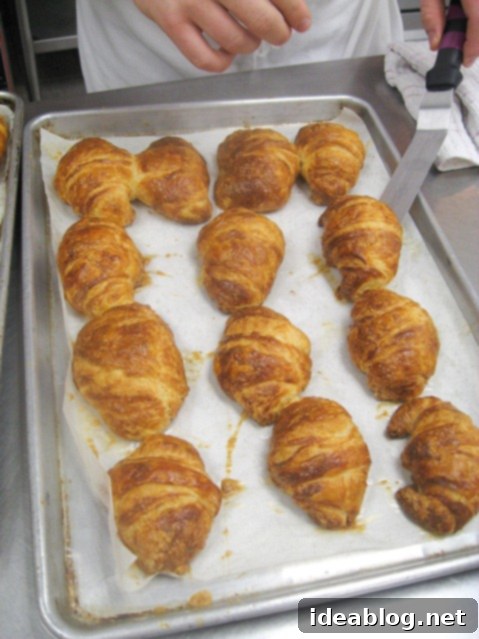Culinary School Chronicles: Mastering Lamb Week and Classic Gastronomy
The past week has been an intense whirlwind of culinary challenges and academic pressures, marking a pivotal moment as we stand merely two weeks away from embarking on our restaurant externships. The kitchen has been buzzing with anticipation and stress, as we also gear up for our final, and arguably most crucial, practical exam next week. To top it all off, we just concluded our toughest Market Basket challenge yet last Friday, a true test of improvisation and skill under pressure. Despite the demanding schedule, these experiences are invaluable, honing our abilities and preparing us for the professional world that awaits.
A Delightful Start: The Art of Homemade Croissants
Wednesday’s class began with a truly rewarding experience: baking off a batch of exquisite homemade croissants. The meticulous process had started the previous afternoon with a comprehensive demonstration by our esteemed Phase I pastry chef, whose expertise in lamination and dough handling is unparalleled. We carefully allowed the croissants to proof overnight and into the morning, a critical step that ensures their characteristic airy, flaky texture. The aroma that filled the kitchen as these golden-brown beauties emerged from the oven, just before class commenced, was nothing short of intoxicating. Each bite offered a perfect crisp exterior giving way to a tender, buttery interior – a testament to the precision and patience required in classical French patisserie. This hands-on experience not only solidified our understanding of dough work but also provided a delicious morale boost amidst the week’s pressures.
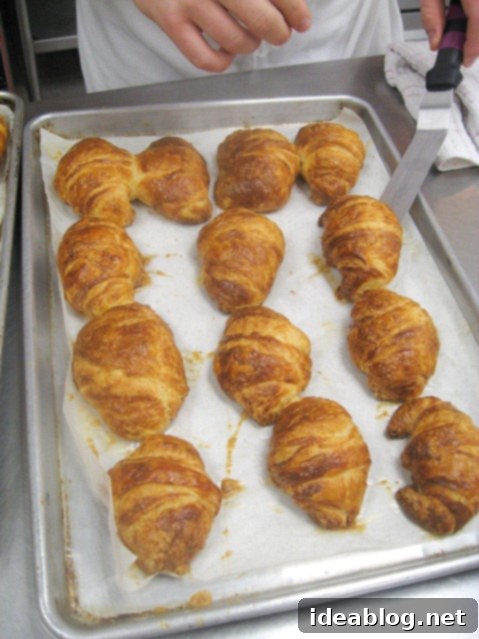
Navigating the “Lamb Week” Challenge
This particular week was designated “lamb week,” an immersive dive into various cuts and preparations of lamb. For many, including myself, lamb remains one of the meats we are least comfortable working with, primarily due to limited prior experience. This intensive focus was therefore incredibly beneficial, pushing us beyond our comfort zones and expanding our repertoire. Mastering lamb is crucial in a professional kitchen, given its distinct flavor profile and the diverse culinary traditions it features in, from Mediterranean to Middle Eastern and beyond. We explored different techniques, from slow braising to pan-searing and roasting, learning how to best enhance its unique qualities and achieve perfect doneness across various cuts. This dedicated week was an invaluable opportunity to build confidence and refine our skills with this versatile and often challenging protein.
Braised Calamari with Soft Polenta and Tomato Sauce
Our first course on Wednesday was a remarkably flavorful braised calamari dish, served elegantly alongside a creamy, soft polenta and a vibrant tomato sauce. Working with calamari is a skill that hasn’t been extensively covered in our program, with only one or two previous encounters. This made the opportunity to revisit and master it particularly exciting. My partner and I eagerly volunteered to handle the entire cleaning process, embracing the challenge for the invaluable extra practice. While it can be a rather messy affair, the steps are quite straightforward once you get the hang of it – removing the quill, entrails, and skin, then meticulously cleaning the tubes and tentacles. For the stuffing, we created a savory mixture of finely sautéed onions, spicy chorizo sausage, and perfectly cooked rice, all bound together with fresh eggs and a touch of breadcrumbs. This rich filling was then carefully piped into the cleaned calamari tubes. Finally, we quickly braised the stuffed calamari in a classic, aromatic tomato and basil sauce, allowing the flavors to meld beautifully. The result was tender calamari bursting with savory filling, perfectly complemented by the smooth polenta and bright tomato sauce, showcasing a balance of textures and tastes.
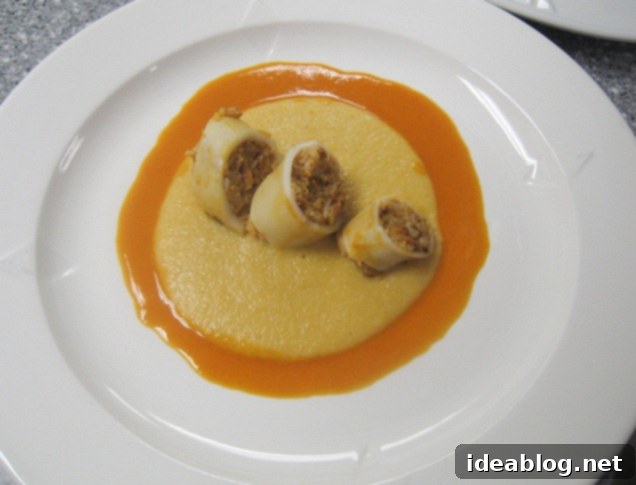
A Modern Take on a Classic: Grilled Caesar Salad
Following the calamari, we presented a creative twist on a true classic: the Caesar Salad. We had previously prepared the traditional version in Phase I, so this iteration felt like a sophisticated, almost deconstructed interpretation. Instead of simply tossing the romaine, we imparted a smoky depth by quickly grilling the romaine hearts, which softened them slightly and added a wonderfully charred flavor. The traditional anchovy and Parmesan elements, typically incorporated into the dressing, were reimagined. We artfully placed whole, high-quality anchovies directly on top of the salad, allowing their distinct umami flavor to shine independently. Perhaps the most charming innovation was the creation of delicate Parmesan “lollipops.” These involved forming small discs of Parmesan and then searing them gently until crisp, before inserting skewers – a playful and elegant way to present the cheese. The dark, intriguing center of each lollipop was actually a tiny, flavorful spoonful of tapenade, adding an unexpected burst of brininess and complexity. This dish brilliantly demonstrated how classic recipes can be innovated upon while respecting their core elements, offering a fresh and exciting dining experience.
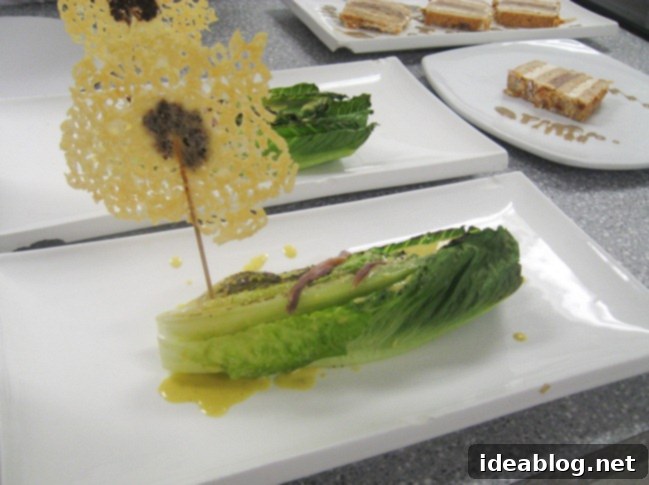
Mastering Mediterranean Moussaka
For our main course, we tackled moussaka, a beloved and hearty classic of Mediterranean cuisine. This layered dish typically features succulent eggplant, ripe tomatoes, savory ground lamb, and a rich, creamy béchamel sauce. To elevate the flavor profile of our moussaka, we took an extra step, carefully sautéing both the eggplant and the tomatoes before assembling the dish. This pre-cooking process deepens their flavors, removing excess moisture from the eggplant and intensifying the sweetness of the tomatoes, resulting in a more concentrated and delicious final product. We assembled our moussaka in individual soufflé molds, aiming for an elegant, portion-controlled presentation. Each layer was meticulously placed: a base of sautéed eggplant, followed by a robust mixture of seasoned ground lamb and tomatoes, and finally, a generous topping of velvety béchamel, baked until golden brown and bubbly. The moussaka was served with a flavorful lamb jus, enriched with the piquant addition of grainy mustard, which cut through the richness of the dish beautifully. While the taste was undeniably satisfying, flipping these delicate creations out of their molds and plating them nicely during service proved to be quite a challenge, requiring precision and a steady hand. Nonetheless, it was a fantastic exercise in classic Mediterranean cooking and presentation.
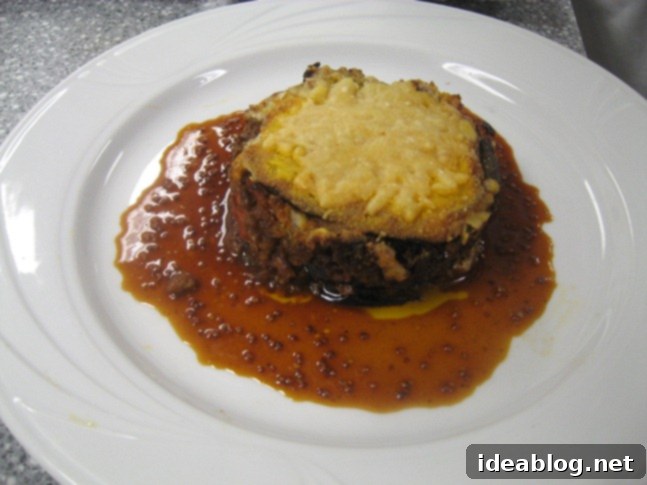
An Unforgettable Dessert: Chef Michel’s Lion D’Or Cake
To conclude our remarkable meal, we had the distinct privilege of preparing a truly legendary dessert, courtesy of Chef Michel. This extraordinary cake, known as the Lion D’Or Cake, was a celebrated bestseller for over two decades at the illustrious restaurant Lion D’Or. Though the restaurant is no longer in operation today, during its tenure, it was consistently heralded as one of the finest dining establishments in the world. Learning to recreate such a significant piece of culinary history was an immense honor and a fantastic learning experience.
The preparation of this iconic dessert is a testament to the dedication required in haute cuisine, as it genuinely takes approximately three days to complete. The secret to its profound flavor and unique texture lies in its meticulously prepared candied hazelnuts and almonds. These nuts undergo a precise candying process, after which they need to dry out for an extensive period—about two to three days. This crucial drying stage ensures that when they are finally ground, they possess the perfect texture and concentrated flavor profile. The finely ground candied nuts are then incorporated into both the delicate sponge cake batter, imparting a rich, nutty essence, and generously folded into one of the whipped cream fillings, adding delightful texture and depth. Even tasted on their own, these candied nuts were incredibly delicious, hinting at the complexity they would bring to the final cake.
The finished Lion D’Or cake was an absolute masterpiece – rich, incredibly flavorful, and beautifully balanced. Its taste and elegant appearance immediately reminded me of another sophisticated dessert we had mastered in Phase I, the Marjolaine cake. Both cakes share a similar complexity in construction and a sophisticated blend of nutty and creamy elements, showcasing the artistry of classic French pastry. Mastering such a multi-stage, historically significant dessert was a highlight of the week, reinforcing the importance of patience, precision, and an appreciation for culinary heritage.
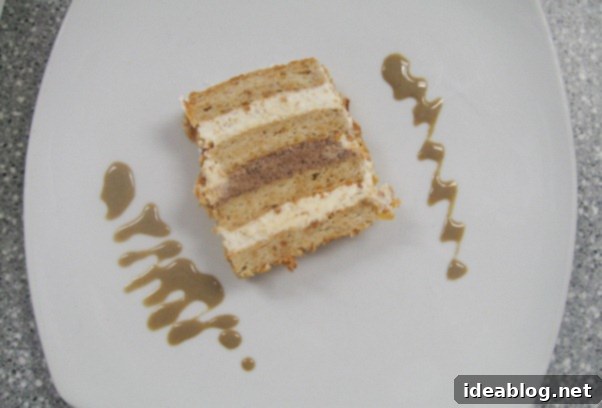
The week has been incredibly demanding, but the lessons learned and skills acquired are truly invaluable. As we reflect on these culinary adventures, the reality of our impending graduation and the start of our externships looms large. It’s hard to believe that we truly have only 8 more days of school left! I’ll be back soon with a short recap on the rest of the week’s events and preparations for our exciting next steps.
